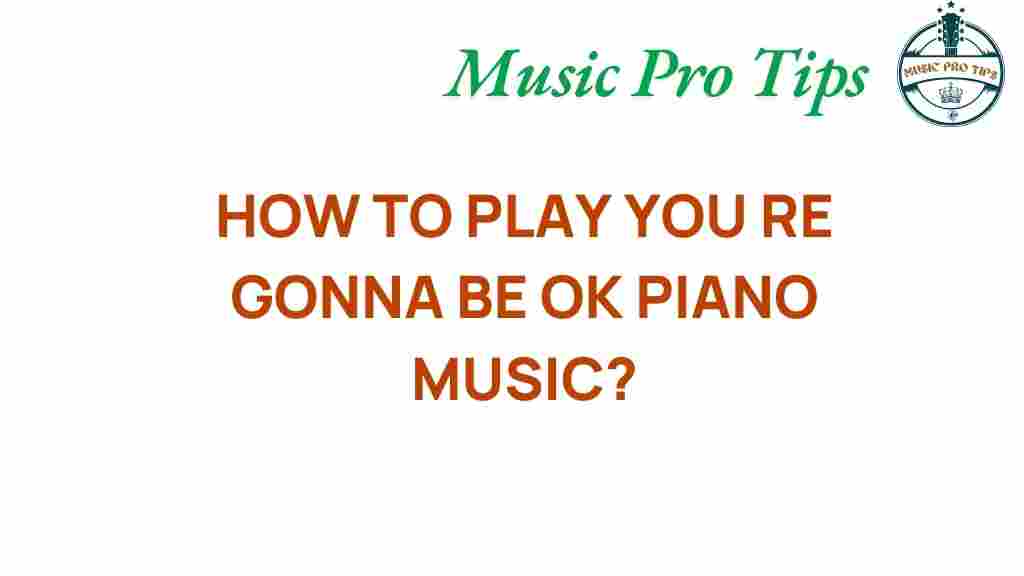Mastering the Art of “You’re Gonna Be Okay”: A Piano Tutorial
Learning to play the piano can be a deeply rewarding experience, especially when you dive into emotional songs like “You’re Gonna Be Okay.” This beautiful piece resonates with many and offers a perfect opportunity for beginners to enhance their skills. In this comprehensive piano tutorial, we will explore the fundamentals of playing “You’re Gonna Be Okay,” delve into essential music theory, and provide tips on piano techniques that will elevate your playing. Whether you are just starting your music lessons or looking to refine your skills, this guide is designed to help you play piano with confidence.
Understanding the Song
“You’re Gonna Be Okay” is an emotional song that conveys a message of hope and reassurance. Before diving into the piano tutorial, it’s important to listen to the song a few times to get a feel for its melody and mood. Here are some key aspects to consider:
- Genre: The song falls under the contemporary genre, making it relatable and appealing to a wide audience.
- Emotion: The piece evokes feelings of comfort, which is essential to convey through your playing.
- Structure: Understanding the song’s structure—verses, chorus, and bridge—will help you learn it more effectively.
Step-by-Step Piano Tutorial
Now that you have a basic understanding of the song, let’s break down the process of learning how to play it on the piano.
Step 1: Familiarize Yourself with the Music
Before you sit down at the piano, it’s crucial to familiarize yourself with the music. Here’s how:
- Listen to the song multiple times.
- Read the lyrics to understand the emotional context.
- Find a reliable sheet music source or a piano arrangement online.
Step 2: Basic Music Theory
Understanding some basic music theory will significantly aid your learning process. Here are a few concepts to grasp:
- Note Names: Learn the names of the notes on the piano (C, D, E, F, G, A, B).
- Scales: Familiarize yourself with the C major scale, which is often used in beginner piano pieces.
- Chords: Understand major and minor chords, as they form the basis of many songs.
Step 3: Break Down the Song
Once you’re comfortable with the music theory, it’s time to break down “You’re Gonna Be Okay” into manageable sections:
- Start with the intro: Play the first few notes slowly.
- Work on the verses: Focus on the left hand chords while adding the melody with your right hand.
- Practice the chorus: This section often has the most emotional weight, so emphasize dynamics.
Step 4: Combine Hands
After practicing each hand separately, it’s time to combine them:
- Start slowly, ensuring both hands are synchronized.
- Use a metronome to maintain a steady tempo.
- Gradually increase the speed as you gain confidence.
Step 5: Add Expression
To truly master “You’re Gonna Be Okay,” you’ll want to add expression to your playing. Here are some techniques:
- Dynamics: Vary the volume of your playing to convey emotion.
- Pedaling: Use the sustain pedal to create a more resonant sound.
- Emphasis: Highlight particular notes or phrases for emotional impact.
Troubleshooting Tips
As you embark on this musical journey, you may encounter some challenges. Here are a few common issues and their solutions:
- Struggling with Timing: Use a metronome to practice keeping a steady beat.
- Difficulty with Hand Coordination: Focus on playing hands separately until you feel comfortable combining them.
- Feeling Overwhelmed: Break the song into smaller sections and tackle one at a time.
Practice Techniques for Beginners
To ensure steady progress in your piano lessons, consider implementing these practice techniques:
- Regular Practice: Aim for at least 20-30 minutes of practice each day.
- Set Goals: Have specific goals for each practice session, such as mastering a section or improving your tempo.
- Record Yourself: Listening to recordings of your playing can help identify areas for improvement.
Conclusion
Mastering “You’re Gonna Be Okay” on the piano is not just about hitting the right notes; it’s about conveying the emotion behind the music. With dedication, the right music lessons, and consistent practice, you’ll be able to play piano with confidence and grace. As you continue your journey, remember to enjoy the process and embrace the beauty of making music.
For more resources on beginner piano techniques and emotional songs, check out our comprehensive guide. Additionally, for a deeper understanding of music theory, refer to this external resource.
This article is in the category Music Theory and created by MusicProTips Team
